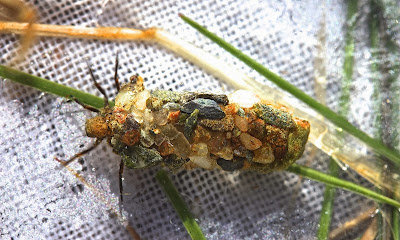I think that it is -- but that's probably because of the streams that I frequent come winter.
Back to Sugar Hollow this morning: the small streams in Sugar Hollow are the "only show in town" at the moment with heavy rains making larger streams (2nd and 3rd order) too high and too fast. Even the Moormans trib that I went to today was higher than normal.
I found two Uenoids on rocks near the shore, both were N. consimilis. I find N. consimilis in all of the small streams I visit in Sugar Hollow; in the Rapidan River; the upper South River before Entry Run; and the upper Doyles River. At a lot of my sites, it's the only Uenoid caddisfly species I see. Last year, further up on the same stream I went to today, I found N. consimilis, N. aniqua and N. mitchelli (see the posting of 2/21/13). Consimilis in 1st order streams is normally found further downstream than aniqua and mitchelli, both slightly less tolerant species. (Aniqua and mitchelli are 0.0; consimilis is 0.3.)
N. consimilis is one of the species with ventral clavate gills, and the head is either uniformly dark brown, or mostly brown with a pale spot/area/stripe on the head.
The reddish orange spot on the head of the consimilis that I found this morning was easy to see -- no microscope needed.
But there is something else that, for me at least, gives this species away. The larvae tend to make a "blocky" looking case, a rectangular shape which tapers very little. Look at the N. consimilis Uenoids in the entry I posted last week from South River and Entry Run. And here are some more.
1/4/12: South River
1/18/12: from another small stream in Sugar Hollow
And 1/6/13: Rapidan River
Now be careful, not every N. consimilis makes this kind of case. Note the other consimilis that I found this morning.
Still, when I see that fairly large, rectangular case, I have a good idea of the type of Uenoid I'll be finding inside.
________________
Other photos:
1. A small winter stonefly, Paracapnia angulata. The stream where I normally find this unusual species is on the other side of the valley -- but not far away.
Note the rear wing pads: they're rounded at the bottom (and hairy!), not the truncate shape of Allocapnia nymphs.
2. And the Perlodid stonefly I've seen quite often in Sugar Hollow this season, Malirekus hastatus.
________________
Pretty spot.
I'll probably be back to Sugar Hollow later on in the week, and I'll probably see N. consimilis!














No comments:
Post a Comment